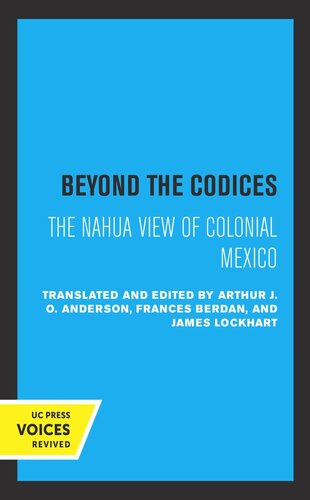

Most ebook files are in PDF format, so you can easily read them using various software such as Foxit Reader or directly on the Google Chrome browser.
Some ebook files are released by publishers in other formats such as .awz, .mobi, .epub, .fb2, etc. You may need to install specific software to read these formats on mobile/PC, such as Calibre.
Please read the tutorial at this link: https://ebookbell.com/faq
We offer FREE conversion to the popular formats you request; however, this may take some time. Therefore, right after payment, please email us, and we will try to provide the service as quickly as possible.
For some exceptional file formats or broken links (if any), please refrain from opening any disputes. Instead, email us first, and we will try to assist within a maximum of 6 hours.
EbookBell Team

4.4
72 reviewsAmong primary materials relating to the history of Mexico, documentation in Nahuatl comprises a special category. Though Nahuatl is a living language, spoken by thousands, one of the facts of life in our profession is that few native Nahuatl speakers ever become historians.
An additional effort is required, by an Eduard Seler or a Robert Barlow or an Arthur J. O. Anderson, if materials in Nahuatl are to be applied to scholarly ends. We have become more familiar in recent years with the literary and philosophical qualities of Nahuatl writing in the work of Angel María Garibay K., and Miguel León-Portilla.
Good progress has been made in translating major Nahuatl texts, particularly the Florentine Codex of Bernardino de Sahagún, by Arthur J. O. Anderson and Charles E. Dibble. And the remarkable work of Pedro Carrasco is casting an ever clearer light on the organization of the Nahuatl-speaking societies of conquest times.
In Europe and America, the new generation of students, more than its predecessors, seems to be aware of the applicability of existing Nahuatl studies and the need for new ones. The demand and the opportunity are obvious, and we can expect to see steady advances in the years to come.
The present important volume both calls attention to the opportunity and prefigures the advance. It is an anthology of Nahuatl documents drawn principally from the McAfee Collection of UCLA and the Ramo de Tierras Collection of Mexico’s National Archive, relating to the municipalities, estates, lands, and occupations of the Nahuatl-speaking Indians of Mexico.
The thirty-six items range from Soconusco to Durango, and from the sixteenth to the eighteenth centuries. Each is printed in Nahuatl and English, with explanatory annotations.
Introductory articles discuss the ethnohistorical, linguistic, documentary, and other implications. The emphasis is both cautionary (“we wish to underline the speculative nature of the rendition of many passages,” p. 40) a